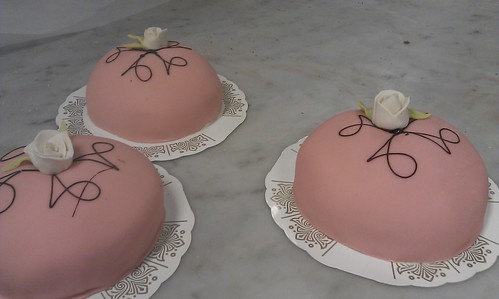What should we talk about today? There has been so much going on. I keep on baking every day, every week... and I'm loving it. This week I focused on baking different types of cakes in school. I've been making them from scratch starting one day by making the base for the cakes in masses and the next few days putting them all together. It has been great fun and to be honest I think I fall in love a little with each one of my cakes. They're all a piece of art in their own way and the ones that don't come out perfect still symbolize my path to becoming more experienced and a better cake crafter.
Anyway, on to something that might interest you a little more. This weekend was my mother's birthday and I ofcourse had the pleasure of baking the desserts for her party. She requested a rerun on the minty marshmallow fluff cake that I made this summer. She really likes that cake. It's like the smoothest textured icecream cake you've ever had and it's so easy to make. Nobody would ever know!
Frozen Candy Cane Cake
For the crust:
20 chocolate cookies/bisquits
2 tablespoons cocoa
For the icecream fluff:
5 deciliters heavy cream
1 jar of marshmallow fluff
peppermint oil/essence/flavour
red food coloring
candy canes
For the chocolate sauce:
125 grams dark chocolate
75 grams butter
½ deciliter sugar
½ deciliter light syrup
salt
½ deciliter water
The crust:
Melt the butter, put the cookies, butter and cocoa in a food processor and mix until it's all crumbs.
Press into a springform, press some up on the sides if you wish, else just make the bottom a little thicker. Put in the freezer for now.
The icecream fluff:
Whip the cream until soft peaks form.
Mix the marshmallow fluff with some of the whipped cream until it's loose enough to easily fold into the rest of the whipped cream. Do so.
Add peppermint flavour to taste. Put about a third of the mixture in a separate bowl and save for later.
Crush the candy canes with a pestle and mortar until fairly finely crushed. It's ok if there are some larger bits.
Mix the crushed candy canes with the larger batch of fluff. Pour this mixture into the springform.
Take the rest of the mixture and add a few drops of red food coloring until nice and pink. Drop blobs of this onto the cake.
Use a knife to slightly swirl it around, mixing it with the rest of the fluff.
Put back in the freezer for atleast 5 hours but it can be made well in advance.
The chocolate sauce:
Put all the ingredients for the sauce in a pot and bring to a boil.
Stir until all chocolate has melted.
Let the sauce simmer for about 10 minutes or until the sauce thickens and gets glossy.
Personally mine never thickens while it's boiling but 10 minutes is usually good enough. You can make the sauce in advance as well and when it's time to serve just take the cake out of the freezer 5 minutes ahead of time and reheat the sauce in the microwave.
This cake is so nummy if you put the warm sauce in the bottom of a plate and put a slice of cake on top of it. The flavours in the crust really comes out then. That's all for today. Next time I'll tell you about this really nummy buttercream that I used for the biskvies that I made for my mother's party as well.
A Swedish girl deep diving into the world of cake... and sharing the Swedish blog-world's recipes with the internationals.
Sunday, November 27, 2011
Monday, November 14, 2011
Pear Marmalade with Honey
I've been posting alot about my baking adventures lately but I hardly ever post any recipes. Originally I wasn't going to . I wanted this blog to be about my adventures and the things I've learned on my quest but let's face it. How mean isn't it to post about all these nummy things and not tell you how to make them? So I will slowly start adding my recipes as well. It's probably a good idea. That way I have everything gathered in one place and I wont lose my recipes or confuse them with each other.
Pear Marmalade with Honey
1.5 kg Pears(peeled and cored)
1 Lemon(0.75 dl lemon juice)
25 g Ginger(fresh)
500 g Jam Sugar(syltsocker)
3 tablespoons Honey
Afgter peeling and coreing the pears, cut them into small pieces and put them in a pot.
Squeeze the lemon and pour this over the pears.
Bring the pears to a boil then simmer on low heat for about 10 minutes(until the pears are soft and mushy).
Peel the ginger and cut them julienne(or in small pieces).
Add ginger, jam sugar and honey to the pot and let it boil strongly for at least 2 minutes.
Put the pot aside and leave it for 5 minutes.
After 5 minutes, skim the pot using a perforated ladle.
Pour the marmalade into hot, sterilized jars.
This marmalade is very sweet and it's hard to decide whether it's more like honey or more like marmalade. I made3 a second batch and reduced the jam sugar to about 425-450 gram and it turned out much better in my opinion.
Now let's talk about methods. When I make jam and other perserves I prefer to use air tight glas jars. I start by cleaning them thoroughly. Even if they're already clean. It's very important to use very clean jars. I then pop them in the oven on a damp towel on a low heat(about 100C) for at least 20 minutes.
Right before it's time to fill them I take them out of the oven and rinse the insides with a little bit of Sodium Benzoate dissolved in water.
When the jars have been filled I immediately put the lid on, turn them upside down and leave them until cooled off completely.
If you want to take things one step further you can also mix some Sodium Benzoate with a spoonfull of marmalade which you then mix with the rest of the marmalade.
And if you don't want your marmalade to turn brown you might also consider adding some Ascorbic Acid to the marmalade.
Both the Ascorbic Acid and the Sodium Benzoate can be bought in a regular grocery store. Usually near the baking supplies. Dosage for mixing it into jams and marmalades is usually found on the package. For the rinse I mix about half a teaspoon of Sodium Benzoate and half a litre of water.
Pear Marmalade with Honey
1.5 kg Pears(peeled and cored)
1 Lemon(0.75 dl lemon juice)
25 g Ginger(fresh)
500 g Jam Sugar(syltsocker)
3 tablespoons Honey
Afgter peeling and coreing the pears, cut them into small pieces and put them in a pot.
Squeeze the lemon and pour this over the pears.
Bring the pears to a boil then simmer on low heat for about 10 minutes(until the pears are soft and mushy).
Peel the ginger and cut them julienne(or in small pieces).
Add ginger, jam sugar and honey to the pot and let it boil strongly for at least 2 minutes.
Put the pot aside and leave it for 5 minutes.
After 5 minutes, skim the pot using a perforated ladle.
Pour the marmalade into hot, sterilized jars.
This marmalade is very sweet and it's hard to decide whether it's more like honey or more like marmalade. I made3 a second batch and reduced the jam sugar to about 425-450 gram and it turned out much better in my opinion.
Now let's talk about methods. When I make jam and other perserves I prefer to use air tight glas jars. I start by cleaning them thoroughly. Even if they're already clean. It's very important to use very clean jars. I then pop them in the oven on a damp towel on a low heat(about 100C) for at least 20 minutes.
Right before it's time to fill them I take them out of the oven and rinse the insides with a little bit of Sodium Benzoate dissolved in water.
When the jars have been filled I immediately put the lid on, turn them upside down and leave them until cooled off completely.
If you want to take things one step further you can also mix some Sodium Benzoate with a spoonfull of marmalade which you then mix with the rest of the marmalade.
And if you don't want your marmalade to turn brown you might also consider adding some Ascorbic Acid to the marmalade.
Both the Ascorbic Acid and the Sodium Benzoate can be bought in a regular grocery store. Usually near the baking supplies. Dosage for mixing it into jams and marmalades is usually found on the package. For the rinse I mix about half a teaspoon of Sodium Benzoate and half a litre of water.
Friday, November 11, 2011
Glögg - a Swedish Christmas Tradition
A few days ago(three to be exact) I started a project: to try to make my first glögg ever. Usually I just buy my glögg at the liqeur store. They have great varieties there. Some with raspberry, some with whiskey, vanilla. Every year there's a glögg of the year, a speciall flavor but a few days go I decided to make my own. It's not hard if you take a small shortcut and skip fermentation.
Do you guys know what glögg is by the way? In case you don't; It's a Swedish version of eggnogg I suppose. It isn't anything like an egg nog but it is what we drink around christmas. Originally to keep warm during the cold winters. The word glögg comes from the word "glödga" which originally meant "to heat up". Glögg is, simplified, wine that has been spiced up with Christmas spices, sweetened and then heated up. I heat mine to about 55-58C.
Some glögg can be overpowering if it's been spiced up with too much whiskey or sherry. The recipe that I found, however, had a perfect balance of spices and sweetness and eventhough it is quite potent the taste isn't overpowered with hard liqeur. I found the recipe on a Swedish blog called Kastrullresan and I find that place very inspiring. You can visit it here: http://www.kastrullresan.com/
If you want to try a typical Swedish Christmas tradition, here is the recipe. Translated and everything. =)
You'r going to need:
15 cl of vodka or other pure, hard liqeur
10 gram Cinnamon
1 ½ gram Clove(about 20?)
1 piece of dried Ginger
2 gram crushed Cardamom
½ Seville orange peel
1 litre Red whine(any, cheap kind will do)
2 deciliter Sugar
1 teaspoon vanilla sugar
Step one:
Crush the cardamon
Break up the cinnamon into smaller pieces
Put the cinnamon, clove, ginger, cardamom and seville in a glass jar.
Pour the liqeur on top and close the lid/cover.
Leave this for about 3 days, less if you want a less Christmassy taste.
Step two:
After 3 days strain the liquid and put it in a pot. Add the wine, sugar and vanilla sugar and head slowly on low head. Don't let it boil or the alcohol will evaporate. Stirr once in a while until the sugars have dissolved completely. Done!
The taste will improve even more if you leave this until the year after, in sealed bottles. But I suspect my glögg wont survive that long, sadly.
Reheat the glögg before serving. In Sweden we serve it in small glasses and add raisins and blanched almonds. Enjoy!
Do you guys know what glögg is by the way? In case you don't; It's a Swedish version of eggnogg I suppose. It isn't anything like an egg nog but it is what we drink around christmas. Originally to keep warm during the cold winters. The word glögg comes from the word "glödga" which originally meant "to heat up". Glögg is, simplified, wine that has been spiced up with Christmas spices, sweetened and then heated up. I heat mine to about 55-58C.
Some glögg can be overpowering if it's been spiced up with too much whiskey or sherry. The recipe that I found, however, had a perfect balance of spices and sweetness and eventhough it is quite potent the taste isn't overpowered with hard liqeur. I found the recipe on a Swedish blog called Kastrullresan and I find that place very inspiring. You can visit it here: http://www.kastrullresan.com/
If you want to try a typical Swedish Christmas tradition, here is the recipe. Translated and everything. =)
You'r going to need:
15 cl of vodka or other pure, hard liqeur
10 gram Cinnamon
1 ½ gram Clove(about 20?)
1 piece of dried Ginger
2 gram crushed Cardamom
½ Seville orange peel
1 litre Red whine(any, cheap kind will do)
2 deciliter Sugar
1 teaspoon vanilla sugar
Step one:
Crush the cardamon
Break up the cinnamon into smaller pieces
Put the cinnamon, clove, ginger, cardamom and seville in a glass jar.
Pour the liqeur on top and close the lid/cover.
Leave this for about 3 days, less if you want a less Christmassy taste.
Step two:
After 3 days strain the liquid and put it in a pot. Add the wine, sugar and vanilla sugar and head slowly on low head. Don't let it boil or the alcohol will evaporate. Stirr once in a while until the sugars have dissolved completely. Done!
The taste will improve even more if you leave this until the year after, in sealed bottles. But I suspect my glögg wont survive that long, sadly.
Reheat the glögg before serving. In Sweden we serve it in small glasses and add raisins and blanched almonds. Enjoy!
Tuesday, November 8, 2011
Raspberry Mousse Cake
In Sweden we honor our dead once a year on all saints day by going to the graveyard, placing flowers and lighting candles. It's a nice oportunity to stop and just remember. In a stressful world as ours. It is so beautiful this time of the year when the light is fading and the memorial park is full of flowers and candles. It always leaves me in a spiritual mood..
After a fairly cold evening at the graveyard we usually go home and have a nice dinner with family and relatives. Since our family is growing quite large I offered to help out by making desert. This time I decided on a wonderful combination of raspberry mousse on a chewy chocolate mudcake base. It looks professional, tastes wonderful and doesn't require too much effort. This was my first time making a mousse cake so I was a little bit worried about whether I could pull it off or not. Therefore I made a small batch a few days ahead to test the recipe. I made the small batch in large american cupcake liners. This also works great if you want to serve portion sizes. I could even peel the liners off leaving a small portion sized mousse cake. Cute.
Anyway, this is what the actual cakes looked like. I topped them with some chocolate just because I had some melted chocolate left over from when I made the cookies and rather than wasting it I decided to use it to practice.
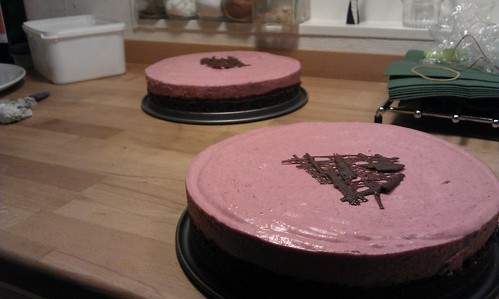
After a fairly cold evening at the graveyard we usually go home and have a nice dinner with family and relatives. Since our family is growing quite large I offered to help out by making desert. This time I decided on a wonderful combination of raspberry mousse on a chewy chocolate mudcake base. It looks professional, tastes wonderful and doesn't require too much effort. This was my first time making a mousse cake so I was a little bit worried about whether I could pull it off or not. Therefore I made a small batch a few days ahead to test the recipe. I made the small batch in large american cupcake liners. This also works great if you want to serve portion sizes. I could even peel the liners off leaving a small portion sized mousse cake. Cute.
Anyway, this is what the actual cakes looked like. I topped them with some chocolate just because I had some melted chocolate left over from when I made the cookies and rather than wasting it I decided to use it to practice.

Sunday, November 6, 2011
One day a few weeks ago the neighbor came knocking on our door. He asked if we wanted pears off his pear tree before he threw them out. All we had to do was to go pick them. That is how I ended up with 17 kilos of very sweet and juicy pears. That was the perfect oportunity to make marmalade and jams. Spread out over the weeks I have been trying different recipes. It's not hard at all to make marmalade. Especially not if you use the special sugar with added pectin. It is a bit time consuimg though. Especially if you want to be thourough and sterilize jars and so on.
After a few days spent in the kitchen peeling, dicing and boiling pears I ended up with quite the collection of jams as well as a few jars of pear sauce. There's pear marmalade with honey and ginger, pear marmalade with lemon and vanilla and pear marmalade with lemon, ginger and walnuts. They are all very nummy and so far we have opened a couple of jars of the honey marmalade - it's great with some brie white mold cheese.
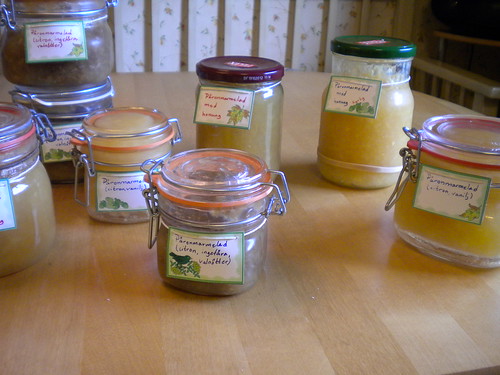
I even printed out some nice tags for the jars so that I don't forget whats in them.
After a few days spent in the kitchen peeling, dicing and boiling pears I ended up with quite the collection of jams as well as a few jars of pear sauce. There's pear marmalade with honey and ginger, pear marmalade with lemon and vanilla and pear marmalade with lemon, ginger and walnuts. They are all very nummy and so far we have opened a couple of jars of the honey marmalade - it's great with some brie white mold cheese.

I even printed out some nice tags for the jars so that I don't forget whats in them.
Sourdough Bread - My first Herman
As I mentioned in my last, rather messy post, I have been baking alot. I have learned so much over the past few weeks and I have gained some confidence in working with different types of dough. You might even say that I've lost some respect for dough which is making me more daring. =)
This in turn has led to my first little baby steps into the world of sourdough. As you probably know the first thing you need to do when you want to play with sourdough is to make a sour dough base. A Herman - as many people would call it. This can be made in many different ways but the method that I used was based on raisin soaked in water and mixed with some different types of flour. This is then set to rest somewhere nice and warm for a few days while you feed him flour and water once in a while as well as shaking him twice a day. on the 5th day or so he should be bubbling rather vigorously. My Herman even bubbled over the icecream box that I was storing him in - making a huge mess of sourdough puke inside my cupboard. Bad Herman!
Anyway, once the base is ready it can be used in all kinds of nummy breads using little or no yeast. Most recipes choose to use yeast anyway to secure the rising process and make it a little faster because sourdough needs to rise much longer than ordinary bread. Some for hours, some for DAYS!
Here is the result of my very first sourdough bread. I am actually very satisfied with this bread. It is a very rustic looking bread that would look great next to that shabby chic cupcake black board(the one I never actually bought). This bread smelled so good and the crunchy crust and sort of half chewy texture completed the experience.
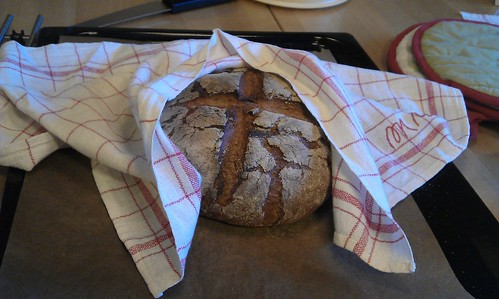
I might actually suggest that this is the best bread I've ever eaten.

This in turn has led to my first little baby steps into the world of sourdough. As you probably know the first thing you need to do when you want to play with sourdough is to make a sour dough base. A Herman - as many people would call it. This can be made in many different ways but the method that I used was based on raisin soaked in water and mixed with some different types of flour. This is then set to rest somewhere nice and warm for a few days while you feed him flour and water once in a while as well as shaking him twice a day. on the 5th day or so he should be bubbling rather vigorously. My Herman even bubbled over the icecream box that I was storing him in - making a huge mess of sourdough puke inside my cupboard. Bad Herman!
Anyway, once the base is ready it can be used in all kinds of nummy breads using little or no yeast. Most recipes choose to use yeast anyway to secure the rising process and make it a little faster because sourdough needs to rise much longer than ordinary bread. Some for hours, some for DAYS!
Here is the result of my very first sourdough bread. I am actually very satisfied with this bread. It is a very rustic looking bread that would look great next to that shabby chic cupcake black board(the one I never actually bought). This bread smelled so good and the crunchy crust and sort of half chewy texture completed the experience.

I might actually suggest that this is the best bread I've ever eaten.

Saturday, November 5, 2011
Wiener Bread
I know this place might seem quiet but boy have I been active. I have been baking more than, I think, ever before in my life and I feel great.
A few weeks ago I started a new education with focus on baking and café life. Every day I spend about 4 hours in the bakery learning how to make different things, work different types of dough and braid using different techniques and I've been using my new skills while baking at home as well. Last weekend I spent almost an entire day playing with what we call wiener bread. It is what you would call a Danish in English as far as I know. The fun part is getting my hands on real bakery recipes - I am copying them all, or as many as I can at least. The only problem is that the recipes usually call for obscene amount of ingredients. One recipe used about 10 kilos of flour - after I HALVED the recipe. That's hardly something I would do at home. I would need to borrow the whole neighborhood's freezers to store all the bread that would give me.
Anyway, here are some pictures of the Danishes that I made at home last week.
This is the classic type of wiener bread that you will most likely find in a store or bakery shop.
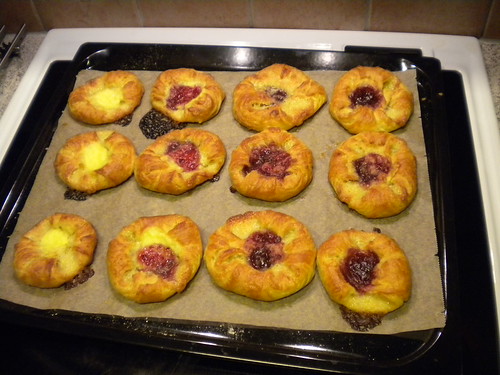
And here is my favorite. It doesn't have jam or vanilla custard filling like the ones in the picture above, but it is so moist and nummy, and a little less sweet. This braid that I made isn't very visually appealing because I made it a little too big. I probably could have made 4 braids instead of 2 with that amount of dough. Maybe next time.

And here is the inside of my favorite braid. You can see all the layers of dough and how moist and gooey it is.

In case you have no idea what wiener bread is all about, this is how it's made: You start by making a dough that is similar to the ordinary sweet wheat based dough but you don't quite knead it as hard. It can be just a little bit sticky too. You then push your dough out into a big square and put a big block of margarine in the middle. Fold/pull in the edges over the butter to cover it, then beat it a little bit until the dough and butter is stuck together. You then grab your rolling pin and roll it out, gently, into a rectangle. Fold it in 3 parts, turn 45 degrees and let it rest for 5 minutes - possibly in the fridge depending on what kind of margarine you're using. Repeat the steps from rolling pin and on 2 more times and your basic wiener dough is ready to shape into whatever it is you're making.
This method makes the dough very flaky as it bakes and very moist on the inside. Definitely worth the effort.
As for the filling: For the classic style wiener bread you cut out squares of about, say 10 cm, and then you put a small dab of something called remons which is pretty similar to buttercream in the middle of the square. Take each corner and pull it to the center and squish it into the remons. This hole will later be filled with custard or raspberry jam or whatever the baker likes.
There is so much more to talk about and I have so many other projects that I would like to discuss but I just got home from a party and I am exhausted. I hope to update the blog over the next few days to show some of my other baking adventures that I've had lately.
A few weeks ago I started a new education with focus on baking and café life. Every day I spend about 4 hours in the bakery learning how to make different things, work different types of dough and braid using different techniques and I've been using my new skills while baking at home as well. Last weekend I spent almost an entire day playing with what we call wiener bread. It is what you would call a Danish in English as far as I know. The fun part is getting my hands on real bakery recipes - I am copying them all, or as many as I can at least. The only problem is that the recipes usually call for obscene amount of ingredients. One recipe used about 10 kilos of flour - after I HALVED the recipe. That's hardly something I would do at home. I would need to borrow the whole neighborhood's freezers to store all the bread that would give me.
Anyway, here are some pictures of the Danishes that I made at home last week.
This is the classic type of wiener bread that you will most likely find in a store or bakery shop.

And here is my favorite. It doesn't have jam or vanilla custard filling like the ones in the picture above, but it is so moist and nummy, and a little less sweet. This braid that I made isn't very visually appealing because I made it a little too big. I probably could have made 4 braids instead of 2 with that amount of dough. Maybe next time.

And here is the inside of my favorite braid. You can see all the layers of dough and how moist and gooey it is.

In case you have no idea what wiener bread is all about, this is how it's made: You start by making a dough that is similar to the ordinary sweet wheat based dough but you don't quite knead it as hard. It can be just a little bit sticky too. You then push your dough out into a big square and put a big block of margarine in the middle. Fold/pull in the edges over the butter to cover it, then beat it a little bit until the dough and butter is stuck together. You then grab your rolling pin and roll it out, gently, into a rectangle. Fold it in 3 parts, turn 45 degrees and let it rest for 5 minutes - possibly in the fridge depending on what kind of margarine you're using. Repeat the steps from rolling pin and on 2 more times and your basic wiener dough is ready to shape into whatever it is you're making.
This method makes the dough very flaky as it bakes and very moist on the inside. Definitely worth the effort.
As for the filling: For the classic style wiener bread you cut out squares of about, say 10 cm, and then you put a small dab of something called remons which is pretty similar to buttercream in the middle of the square. Take each corner and pull it to the center and squish it into the remons. This hole will later be filled with custard or raspberry jam or whatever the baker likes.
There is so much more to talk about and I have so many other projects that I would like to discuss but I just got home from a party and I am exhausted. I hope to update the blog over the next few days to show some of my other baking adventures that I've had lately.
Subscribe to:
Posts (Atom)
